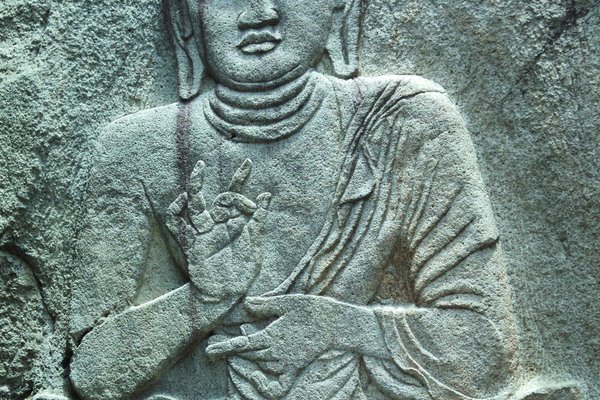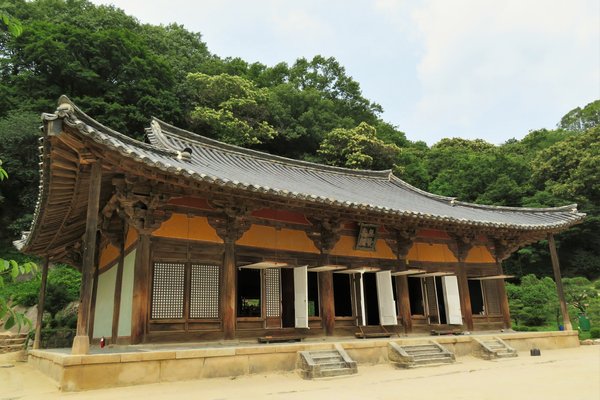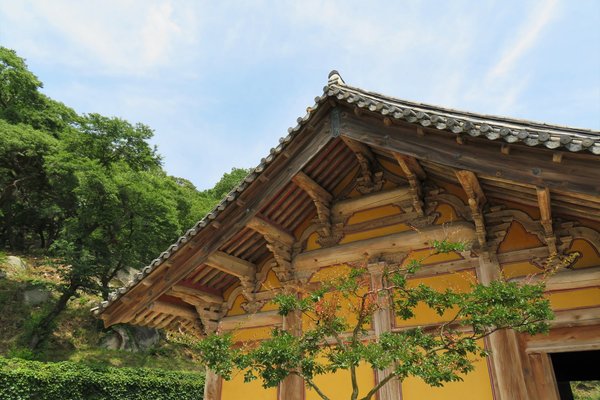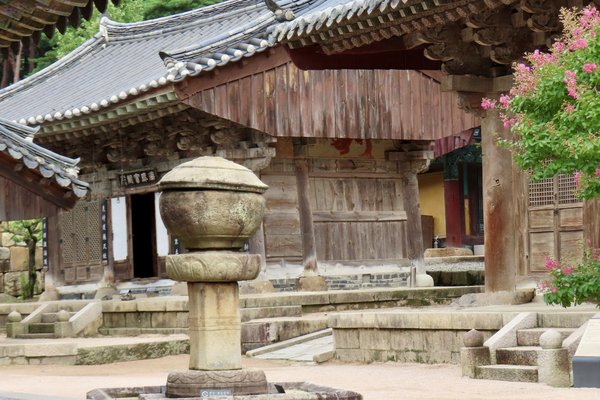Republic of Korea
Sansa, Buddhist Mountain Monasteries
Sansa, Buddhist Mountain Monasteries in Korea, represents the earliest era of Korean Seon Buddhism and its distinctive spiritual practice.
The seven remote monasteries were established in the 7th to 9th centuries. They prospered during the Goryeo Dynasty which established Buddhism as a state religion. The monasteries are still in use as centers of meditation and Buddhist study and have preserved many of their historic structures, objects and documents.
Community Perspective: Five out of the seven included monasteries (all situated in the southern provinces) have been covered by our reviewers: Tongdosa (GabLabCebu), Buseoksa (Kyle), Beopjusa (Kyle, Frederik), Magoksa (Kyle), and Seonamsa (Clyde, Frederik).
Site Info
Official Information
- Full Name
- Sansa, Buddhist Mountain Monasteries in Korea (ID: 1562)
- Country
- Republic of Korea
- Status
-
Inscribed 2018
Site history
History of Sansa, Buddhist Mountain Monasteries
- 2018: Advisory Body overruled
- ICOMOS advised to only inscribe 4 of the monasteries
- 2018: Inscribed
- Inscribed
- Type
- Cultural
- Criteria
- iii
Links
- UNESCO
- whc.unesco.org
- Official
-
- koreansansa.net — Buddhist Mountain Monasteries in Korea
All Links
UNESCO.org
- whc.unesco.org — whc.unesco.org/
Official Website
- koreansansa.net — Buddhist Mountain Monasteries in Korea
Community Information
- Community Category
- Religious structure: Buddhist
Travel Information
Yeosu Hotspot
Gyeongju hotspot
Recent Connections
-
Bixi
Multiple bixi are located within the St… -
Legends and Folk Myths
Buseoksa (Floating Rock Temple) - "The … -
Stelae
"Daeheungsa Temple retains traces of t…
Connections of Sansa, Buddhist Mountain Monasteries
- History
-
-
Contains significant structures from the 20th Century
Beopjusa Temple "A large 20th century statue of Maitreya stands within the temple" - ICOMOS -
Goryeo
"Despite their origins in the Silla period, much of the architecture of the nominated components represents developments in the later Goryeo and Joseon periods." – ICOMOS -
Three Kingdoms of Korea
Tongdosa Temple was founded in 646 (Silla) -
Silk Roads
Eastern Route; "According to tradition, the Precepts Platform at Tongdosa temple contains a relic of the historical Buddha brought to Silla by Jajang as a gift from Tang China." - Advisory Body Evaluation
-
- Architecture
-
-
Wooden architecture
"The 13th century Hall of Infinite Life is one of the oldest buildings in Korea and an important example of East Asian wooden architecture. Beopjusa contains a large multi-story wooden pavilion which is the largest in Korea." - ICOMOS -
Stand-alone Rock Reliefs
Rock-carved Seated Buddha, Treasure No. 216 (Beopjusa Temple) - Nomination File
-
- World Heritage Process
-
-
Inscribed on a single criterion only
Crit iii
-
- Religion and Belief
-
-
Religious Relics
"Tongdosa Temple does not enshrine an image of the Buddha, because there are relics of the Buddha enshrined in the Diamond Precept Platform." - ICOMOS -
Shamanism
"For each of the nominated components, the State Party describes a rich array of annual festivals, rites and continuing spiritual practices at the temples, including some that incorporate local belief systems (such as shrines dedicated to the Mountain Spirit, longevity totems associated with Taoism and Shamanism.." (AB ev) -
Taoism
"For each of the nominated components, the State Party describes a rich array of annual festivals, rites and continuing spiritual practices at the temples, including some that incorporate local belief systems (such as shrines dedicated to the Mountain Spirit, longevity totems associated with Taoism and Shamanism.." (AB ev) -
Stupa
Tongdosa: houses the Buddha relics, "Founded by the great monk Jajang in 646, it was originally built to house his collection of Sakyamuni relics that he had acquired on his travels. He put the most important relics in a special budo, or reliquary stupa, on a platform he named Geumgang Gyedan, which can be seen today. " -
Phoenix
Bongjeongsa (Phoenix Dwelling Temple) -
Legends and Folk Myths
Buseoksa (Floating Rock Temple) - "The assimilative character of the temple is handed down in the Shrine of Seonmyo, dedicated to the legendary woman from the founding myth." - (Wiki Buseoksa (see legend)See en.wikipedia.org
-
Pagoda
"Beopjusa contains a large multi-story wooden pavilion which is the largest in Korea. Although more common in other parts of East Asia, there are few extant examples of this kind of architecture in Korea." - ICOMOS; "Palsangjeon Pagoda of Beopjusa Temple is the tallest among the pagodas in Korea and only wooden pagoda remaining today, making it an invaluable part of Korean cultural and historical heritage." - Cultural Heritage Administration of Korea
-
- Human Activity
-
-
Tea
Seonamsa Temple "Tea fields are located at the rear of the temple complex." - Advisory Body Evaluation Daeheungsa Temple also has been renowned for Korean tea culture with Master Choui who revived Korean dado (“the way of tea”) in the 19th century. - Supplementary Information File
-
- Constructions
-
-
Notable Bridges
Seungseongyo Bridge of Seonamsa Temple, Suncheon (Designated as a Treasure in 1963) "Over the stream the Bridge of Ascending Immortals (Seungseongyo) was built in 1713, demonstrating the stone construction technology of the time, and nearby are a number of rocks carved with the names of temple supporters and famous people who visited the temple. These carvings attest to the history of the temple and the beauty of the landscape." - Nomination File -
Bixi
Multiple bixi are located within the Stupa garden at Daeheungsa Temple (Daeheungsa Korean Heritage Service (KHS)) -
Stelae
"Daeheungsa Temple retains traces of the activities of many high priests who led Korean Buddhist in the 17th and 18th centuries. These monks were known as the 12 doctrinal masters and 12 instructors who were the most learned in meditative and doctrinal Buddhism. To honor their memory, Daeheungsa Temple maintains a stupa garden with 47 stupas and steles, including those of Great Master Seosan, which attest to the historicity of the temple." - Nomination File
-
- WHS on Other Lists
-
-
World Biosphere Reserves
Seonamsa Temple, which is one of the components of the Sansa, Buddhist Mountain Monasteries in Korea WHS is located within the Suncheon Biosphere ReserveSee en.unesco.org
-
- Timeline
-
-
Built in the 7th century
Seven temples established in the 7th to 9th centuries have been selected (AB ev)
-
- WHS Hotspots
-
-
Yeosu Hotspot
< than 50km to Seonamsa (direct KTX high-speed train to Suncheon 15 minutes) -
Gyeongju hotspot
< than 50km from Tongdosa
-
- Visiting conditions
- WHS Names
-
-
Translated Toponyms
"Sansa" is a Korean term for any Korean Buddhist temple located on a mountain. Full name in English confirms this "Buddhist Mountain Monasteries".
-
News
No news.
Recent Visitors
Visitors of Sansa, Buddhist Mountain Monasteries
- Alexander Lehmann
- Alexander Parsons
- Alex Goh
- anthonybonbon
- Atila Ege
- Bernard Joseph Esposo Guerrero
- Bigboss99
- bossc
- Can SARICA
- chenboada
- Cheryl
- Christoph
- Christravelblog
- Chunsian01
- Clyde
- CugelVance
- cutecid
- cwthong
- Dimitar Krastev
- DouglasR
- Dr. Caligari
- Elaine McArdle
- Els Slots
- Errol Neo
- Eva Kisgyorgy
- Fan Yibo
- Frederik Dawson
- GabLabCebu
- Garrett
- Hadrianus
- Harald T.
- Harry Mitsidis
- henryjiao18
- inomusay
- Jarek Pokrzywnicki
- Javier
- JL
- Joel on the Road
- Jonas Kremer
- Jon Eshuijs
- Joyce van Soest
- Kasper
- Kim, Soo-youn
- Kristin
- Kyle Magnuson
- Loic Pedras
- Luboang
- Lukasz Palczewski
- Luke LOU
- Maciej Gil
- MaYumin
- Michael Ayers
- Michael Turtle
- Miguel Marquez
- Mihai Dascalu
- Mikan22
- nan
- Nihal Ege
- Patrik
- Paul Schofield
- Petteri
- Philipp Peterer
- Reza
- Roman Bruehwiler
- Shandos Cleaver
- Simonh
- Slavi
- Solivagant
- Stanislaw Warwas
- Stijn
- Thomas Harold Watson
- Timothy C Easton
- tony0001
- Vincent Cheung
- Xiquinho Silva
- Zoë Sheng
- Zos M
Community Reviews
Show full reviews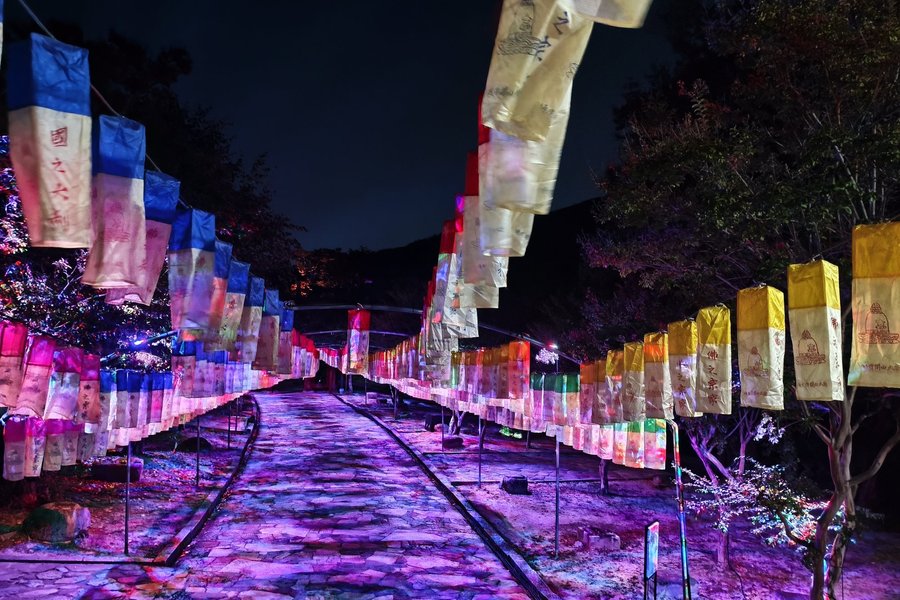
Time of the visit: the 1st of oct.,2025
At 11.30 am I took the direct bus(every 40 min) from Busan Central Bus Terminal,next to the metro stop " Nopo",to Tongdosa-Sinpyeong Bus Terminal.The journey took about 25 min.
The walk to the temple is very easy. You turn right when you leave the bus station and keep walking straight ahead... straight ahead. The path leads directly to the temple. After about 5 minutes, you reach the Yeongchuisanmun Gate. From there, you walk along a charming pedestrian path, separated from the cars by the river. This path is simply beautiful, lined with large old stone lanterns, a cafe in a sort of small temple replica, and Buddhist inscriptions on stone blocks.
GabLabCebu's review hits the nail on the head, but more on that later.
After about a 20-minute walk along a truly fantastic path, you reach a fenced-in area with giant tortoises. I stayed there for a few minutes and took a close look at them. The main gate is directly adjacent. I first visited the wonderful Tongdosa Museum (free entrance), which explains the history of the temple and displays some of its treasures, such as tablets, Buddhist images, statues, prints, and printing plates. I stayed there for about 20 minutes.
The 600 Buddhist paintings rival any other leading museum in the field of Buddhist paintings.Impressive.
Through another gate, the Buriman Gate, the last of four entrance gates, I entered the main complex of smaller and larger temples. Based on our fellow …
Keep reading 0 comments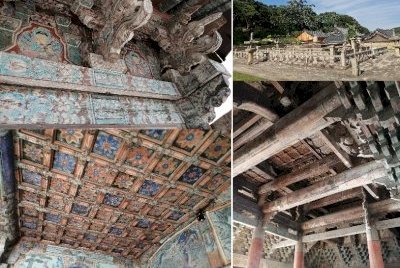
To me, the Sansa embody the ideal and typical Korean temple. They may not have the historic significance of Bulguksa or the unique library of Haeinsa, but they are much better preserved, containing some of the oldest standing wooden architecture in the peninsula, and some of the most beautiful too. For that, I have to say they are a much-needed WHS, and I had a dilemma on which of the seven to fit into my trip to Korea in June 2023. Upon examining the evaluation file, I found that only four were actually advised for inscription - Tongdosa, Buseoksa, Beopjusa,Daeheungsa. Buseoksa and Beopjusa had been covered well by Kyle, and Daeheungsa I found to be too remote to fit into the trip; sadly, I even had to cut Unjusa last minute due to time constraints, so I never could've made it farther southwest. That left Tongdosa, and upon further research, I became more and more surprised that it hasn't truly been reviewed here yet. Tongdosa is one of the three "Jewel Temples" of Korea, representing Gautama Buddha, containing relics of the Buddha, and serving as the head temple of the Jogye Order. Of the three, it's definitely the best preserved, easily trumping Haeinsa and Songgwangsa in this metric, and it's even the largest, not just of the Jewel Temples, but out of all existing temples in Korea! And if that wasn't all enough reason to make it worth the journey, it's within easy reach of Busan, the second largest city …
Keep reading 1 commentFrederik Dawson
Sansa, Buddhist Mountain Monasteries
Sansa, Buddhist Mountain Monasteries (Inscribed)
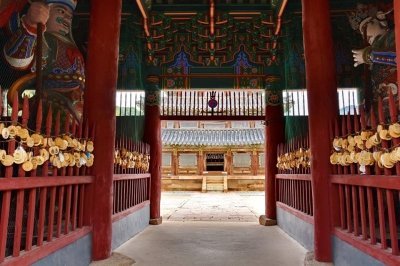
I was initially skeptical about visiting this site, as I had already been to Haeinsa and Bulguksa temples. I was curious about the outstanding universal value of “Sansa,” a term derived from the Chinese word “Shan-si,” meaning mountain temple. Among the inscribed components, I visited only two: Beopjusa and Seonamsa. Both temples are located in protected forests, and the pathways from the parking areas were scenic, with beautiful streams, light forests, pavilions, and pleasant surroundings. However, this kind of environment and setting is quite similar to Haeinsa, so while I thoroughly enjoyed the visit, I struggled to identify the uniqueness of these mountain temples compared to other forest Buddhist temples in Asia or religious monasteries around the world.
One thing I noted about Haeinsa is that, apart from the famous wooden block storage buildings, the rest of the temple complex is not particularly special, most structures have been newly rebuilt. Therefore, I never credited Haeinsa for its temple architecture, only for the storage buildings. My view of Bulguksa’s authenticity is even more negative, as most of the temple structures, except for the two stone pagodas, were reconstructed based on archaeologists’ imagination.
However, when I visited Beopjusa and Seonamsa, the aged wooden structures were stunning, especially the pagoda at Beopjusa. Its antiquity left a strong impression, contrasting sharply with many other temples in South Korea. I walked around the complex trying to understand the concept of “Madang” or open courtyard. The Madang layout made …
Keep reading 1 comment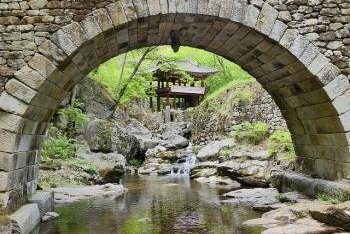
I visited this WHS in April 2017. I visited the Seonamsa Mountain Temple which is located in the Joyesan Provincial Park a few kilometres away from Suncheon.
This mountain temple has undergone several restorations from 1597 through to 1823 but is overall in quite a good state. It has a number of peculiar features such as a lavatory cottage a spiritual pond with an artificial island and a bridge with several Korean script inscriptions and a dragonhead carved in the middle (photo).
It is also possible to do a temple stay here and I'd recommend it even though I didn't stay myself. When I visited, the monks were practicing their drum and cymbal skills on a blackboard with wooden spoons and an empty gas cylinder! The sounds they created in the middle of the national park though were exactly similar to normal drums and cymbals!
The highlight of my visit were the lovely paintings or palsangdo enshrined in the Seonamsa Palsangjeon in which the entire life of Sakyamuni from former life to Nirvana is described in 8 scenes. The temple houses 24 of the most important national and state cultural properties and the Seonamsa Museum displays over 200 cultural properties.
Just before the temple entrance there's a lovely tea house with a very peaceful setting (just before the red wooden 'totems').
Keep reading 0 comments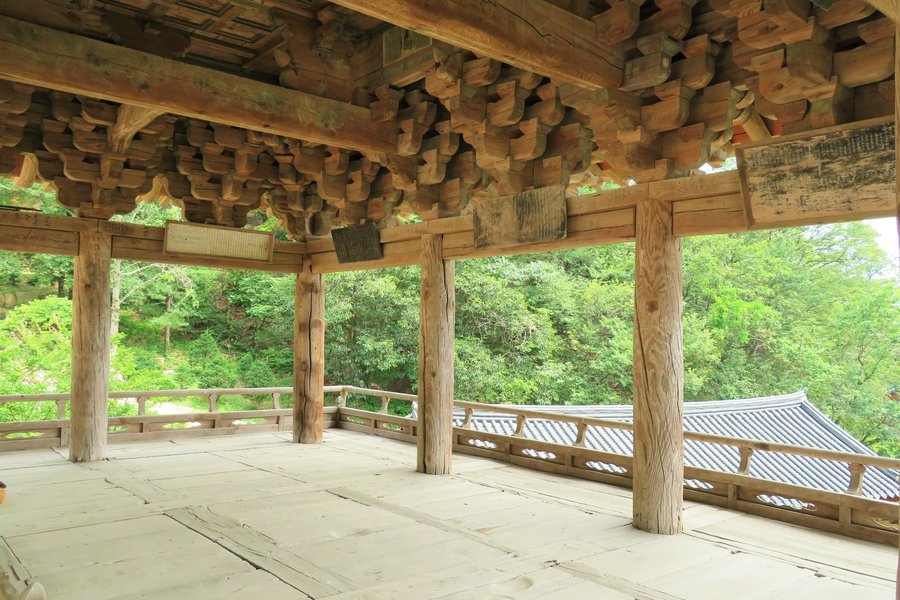
Many visitors to Korea visit Bulguksa or Haeinsa. Both contain Buddhist treasures and provide a great introduction to Korean temples. Yet, I would claim they are not the best representative examples of Korean Buddhism. Here is a great serial WHS for any traveler interested in Korean temples.
Firstly, there are no representative fully intact, active Buddhist temples in Seoul or Gyeonggi-do that truly stand out. This is because during the Joseon dynasty Confucianism was central to the state. Buddhism had not been the state religion since the time of Goryeo. This nomination is sensible in focusing on mountain temples in the more rural areas of Korea. These temples are well-preserved, highly authentic, and most (if not all) have more than one national treasure. Each one of these 7 temples has features or artifacts that make them unique.
Buddhist Mountain Monasteries (Collage)
I visited 4 mountain temples included in this serial property.
1) Beopjusa (Boeun), 2011
2) Buseoksa (Yeongju), 2016
3) Magoksa (Gongju), 2016
4) Tongdosa (Yangsan), 2025
Beopjusa is located in the heart of Korea. Many people visit the temple because it is the starting point for the trek to the summit of Songnisan National Park. The temple has multiple national treasures and treasures. Two noteworthy national treasures are the only preserved 5-story wooden pagoda in Korea and the beautiful Goryeo era rock etching. I found both spectacular. Korea used to be filled with wooden pagodas from 3-9 stories. An incredible number of them were burned down during the Samurai …
Keep reading 0 comments
